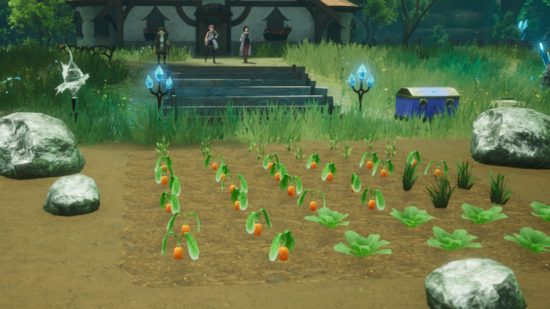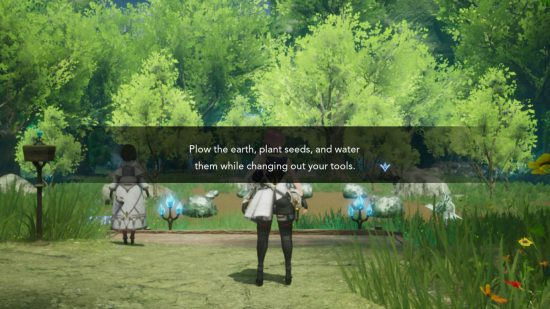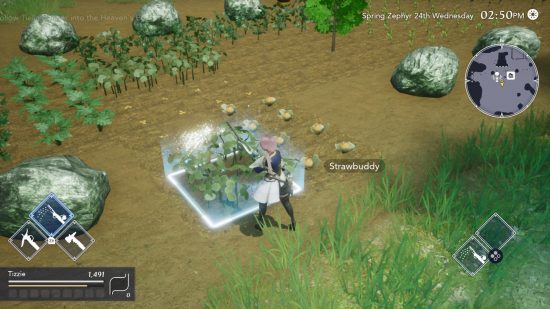Though it has more JRPG DNA in its blood than anything, Harvestella crops are still an important part of gameplay – it wouldn’t have ‘harvest’ in the name, if not. Whether you sell ‘em, process ‘em, or stick ‘em in a stew, you’d be wise to get to grips with the variety of voluptuous veggies and fantastic fruits you can grow. So let’s take a look at all the different crops on offer, their sell prices, and more, while we also tackle the tough task of answering what Harvestella’s best crops are.
If you’re wondering what you can use all this perfect produce for, check out our Harvestella cooking and Harvestella crafting guides. Or, for a different kind of fieldwork, head over to our Harvestella jobs and Harvestella bomb recipe guides.
What are Harvestella crops?
As you may have guessed, Harvestella crops are plants and trees that you tend to on your farm. Each crop has set seasons in which it can grow, and several require special biomes in order to flourish. Most crops need watering every in-game day, and each of them take a specific amount of days to bear produce.
Some crops, like cucumbles, yield more than one item per harvest, and others stick around for a while, allowing you to harvest them multiple times. When Quietus comes around between seasons, all crops except trees, saplings, and shrubs die, and you start again with a fresh slate.
While the main game may focus more on the RPG features such as narrative and combat, farming is still an important part of Harvestella. Planting and harvesting crops not only nets you money when you ship them, but also allows you to produce animal feed, processed ingredients, and meals and drinks that offer stamina, health, and buffs. Becoming a savvy, well-equipped farmer takes some time and patience, but it’s certainly worthwhile.
All Harvestella crops
Below, we list all the Harvestella crops we’ve come across in each location so far, along with their seed/sapling/shrub price, what seasons they grow in, and how much money they sell for. The sell prices are for one standard piece of produce from each crop. We’re still investigating the high-quality produce sell prices at the moment, but we’ll update this guide when we know more. For growth times, check the in-game description of the seeds or saplings.
You may notice that certain crops are listed in more than one location, with different seed costs attributed to them. That’s because these seeds appear in both the locations’ general good stores at different prices. So, if you want to buy some seeds as opposed to picking them up from dungeons or quest rewards, be sure to check that you’re going to the store selling them for the lowest price.
All information here is gathered from my personal playtime in the game, and backed up by the research of the extremely helpful and dedicated community over at r/Harvestella. A big shoutout goes to this post by u/Odeus1019, and this comprehensive spreadsheet by u/iArkeus, both of which helped me solidify my data.
Lethe Harvestella crops
All of the Lethe crops grow in the field, except curry herbs which require the cave biome.
| Crop | Seed cost | Season | Sell price |
| Carrop | 105 | Spring, summer | 115 |
| Cucumble | 370 | Spring | 200 |
| Curry herb | 270 | Spring, summer, fall | 350 |
| Dress lettuce | 55 | Spring, summer, fall | 85 |
| Grass | 30 | Spring, summer, fall | 35 |
| Grouply grape | 2,000 | Fall | 85 |
| Lantern pumpkin | 1,800 | Fall | 3,750 |
| Lumpotato | 90 | Fall, winter | 120 |
| Morrocorn | 230 | Summer, fall | 400 |
| Princess chestnut | 2,200 | Fall | 60 |
| Rainbow bean | 180 | Fall | 40 |
| Royal eggplant | 780 | Fall | 480 |
| Stellar wheat | 40 | Spring, summer, fall | 55 |
| Unionion | 130 | Spring, fall | 195 |
Nemea Harvestella crops
All Nemea Harvestella crops grow in the field, except the nectarcane sapling, which only grows in the water biome.
| Crop | Seed cost | Season | Sell price |
| Carrop | 95 | Spring, summer | 115 |
| Nectarcane | 370 | Spring, summer, fall | 250 |
| Nemean tomato | 170 | Spring, summer | 65 |
| Strawbuddy | 220 | Spring | 130 |
| Tingle radish | 390 | Spring | 530 |
| Unionion | 105 | Spring, fall | 195 |
| Wisty peach | 4,200 | Spring | 115 |
Shatolla Harvestella crops
The islet watermelon, lococonut, netarcane, and honey flower crops all require the water biome to grow. You can plant the rest of the crops in your field.
| Crop | Seed cost | Season | Sell price |
| Bellhop | 560 | Summer | 45 |
| Honey flower | 380 | Spring, summer, fall | 795 |
| Iset watermelon | 2,500 | Summer | 4,600 |
| Lococonut | 3,200 | Spring, summer, fall | 35 |
| Morrocorn | 200 | Summer, fall | 400 |
| Nectarcane | 370 | Spring, summer, fall | 310 |
| Numblemon | 2,200 | Summer | 95 |
| Seatide garlic | 650 | Summer | 1,000 |
| Shatollan paprika | 250 | Summer | 110 |
Argene Harvestella crops
You can only grow sudor peppers, revol peppers, and curry herbs in the cave biome. You can plant the rest in the field.
| Crop | Seed cost | Season | Sell price |
| Argene cabbage | 220 | Winter | 320 |
| Chilly plant | 800 | Winter | 1,300 |
| Curry herb | 240 | Spring, summer, fall | 350 |
| Lumpotato | 80 | Fall, winter | 120 |
| Revol pepper | 560 | Spring, summer, fall | 265 |
| Snowcap mikan | 2,300 | Winter | 65 |
| Sudor pepper | 400 | Spring, summer, fall | 250 |
Harvestella best crops
Working out which is the best Harvestella crop is subjective based on what you’re looking for, and how much you want to invest into farming. If you’re after pure profit, there are a few things to take into consideration. Naturally, some crops sell for more grilla than others, but they can also take many days to grow or, in the case of tree saplings, take up more room on your farm.
Through scouring Reddit and playing the game myself, I’ve found that, so far, these are some of the most profitable crop hustles per season. There are likely plenty of others, so hit us up on the official Pocket Tactics Twitter if you know any gooduns!
Spring
- Wheat and dress lettuce – seeds for these are cheap and readily available, and turn a great profit when turned into picnic sandwiches, making them great early-game crops. However, to cook the sandwiches you need the kitchen counter, and each sandwich takes valuable in-game time to make
- Cucumbles – the best of the spring crops by a large margin, especially if you manage to find or earn seeds as opposed to buying them. The plant takes four days to initially grow, the three days between each harvest. This means you get a total of six cucumbles per plant, selling at 200 grilla each – over time, that’s 1,200 grilla per plant
Summer
- Islet watermelon – as much as its long growth time (12 days!) and water biome requirement is a bit of a turn-off initially, islet watermelons offer a massive profit. Even if you buy the seeds at 2,500 grilla, you still earn over 1k in profit a piece, so you should cherish any watermelon seeds that you snag for free
- Moroccorn – with a short, four-day growth time, morrocorn has a quicker turnover rate and, if you can purchase the seeds from Shatolla as opposed to Lethe, doubles the money you invest into them (200 grilla seed, 400 grilla per crop)
- Seatide garlic – though it has a six-day growth time, seatide garlic nets you a profit of 350 grilla if you buy the seeds, or 1k grilla straight in the pocket if you find the seeds for free
Fall
- Lantern pumpkin – like in Disney Dreamlight Valley, pumpkins are king in Harvestella’s fall. If you purchase a seed for 1,800 grilla, you get a whopping 1950 grilla profit in 11 days’ time, or 3,750 grilla if you find a free seed while out and about
- Moroccorn – just as handy in fall as it is summer (see above)
Winter
- Chilly plant – crop options are pretty limited in winter, and I’ve not fully explored them yet. However, you can buy a chilly plant seed for 800 grilla, and turn a 500 grilla profit after seven days by selling it for 1,300 grilla
That’s all we’ve got on the Harvestella crops so far, but we’ll be sure to update this guide as we crunch more numbers and sell more produce. Next stop, investigating juice and cooking vs raw produce profits! In the meantime, be sure to check out our Harvestella romance guide to see who you can woo with your extensive knowledge of crop rotations.














